Baby Oral Health for Parents
Your Baby’s Mouth
By age two, 16 of the 20 baby teeth have begun to come in. The last teeth to come in are the second molars, which come in during this time (see tooth diagram). Timing of teething may be delayed up to six to nine months and is not unusual or cause for concern.
Remember to avoid using oral gels/teething products as they have been deemed unsafe for teething use in infants and children.

Grain of rice of toothpaste

Begin Flossing
Brush in the morning and before bedtime. Kids love routines so consider making it part of their daily schedule. Fluoride toothpaste should only be applied by the caregiver when brushing. Use a small amount of fluoride toothpaste (size of a grain of rice) in a gentle circular scrubbing motion. Begin using a pea-size amount of fluoride toothpaste once your child is able to spit well. This skill develops between 3 to 6 years of age. Start flossing when your child’s teeth begin to touch (no spacing).
Your child should visit the dentists by their first birthday. If you do not have a dentist that sees young children, ask your doctor for a referral.
- ENAMEL DEFECTS: Look closely at your child’s teeth on a regular basis. If you notice that the teeth are pitted or rough, or have yellow, brown, or white spots, you should contact your dentist. Your child may have enamel defects, and your dentist can work with you to treat if needed. The defects may be mild and look like a ‘birth mark’ like on the tooth.
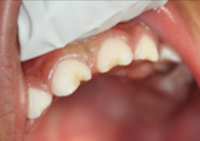
Enamel Defect
-
CAVITIES: Your child’s baby teeth can develop cavities. Cavities will look like small brown spots on the teeth. Read the next section to learn how you can help prevent cavities in your child’s mouth. If your child does get cavities, it is important to have them assessed. Your dentist can determine whether your child has cavities and how best to treat them. The dentist or your child’s doctor may apply a fluoride varnish to your baby’s teeth to help prevent cavities. It is important that you brush your child’s teeth at least twice a day. See the section on Brushing Teeth Tab 2 in Your Baby’s Mouth section for more information.
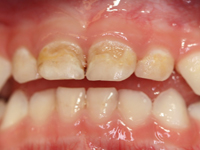
Cavities
- REFLUX: Most children have some reflux or “spitting up”. This can be normal and most children outgrow it. If your child continues to have reflux after the age of 12 to 18 months, talk with your doctor. Reflux can wear on the enamel (outer tooth layer) and affect the baby teeth. Drinking too much cow’s milk can cause reflux. Your child should have no more than 16 ounces (2 cups) of cow’s milk per day.
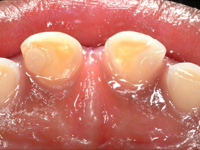
Reflux
- TEETH GRINDING: Your child may ‘grind’ his/her teeth. This is called ‘bruxing’. It is common in children and not related to stress. Most children outgrow bruxing as their adult (permanent) teeth come in. Let your dentist know if your child continues to grind his/her teeth.
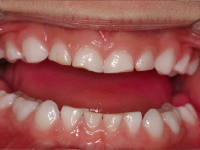
Bruxing/tooth wear
- ‘FUNKY’ TONGUE: Your child may develop irregular, smooth, whitish areas on the tongue that look like a map. The white areas often will look different from one day to another. This may be a condition known as ‘geographic tongue’. This is harmless and usually does not cause discomfort. Talk with your doctor or dentist if your baby seems to be experiencing discomfort.
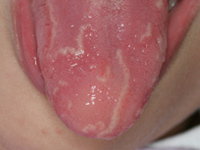
Funky Tongue
- EXTRA TOOTH/MISSING TOOTH: Your child’s teeth form before he/she is born. During this time, a single tooth bud may partially divide (gemination). When this tooth comes in, it may look like two teeth. Or two teeth buds may unite (fusion) and look like one tooth. This may seem like a tooth is missing. Both conditions are harmless, and usually no treatment is needed. An x-ray usually is not indicated at this time.
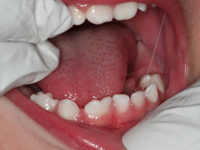
Fused Teeth
-
BLEEDING GUMS: You may notice blood on the toothbrush when you brush your child’s teeth. Bleeding can be a sign of ‘gingivitis’ caused by bacterial plaque on the teeth at the gum line. You should focus on brushing your child’s teeth along the gum line to remove the plaque. Bleeding should stop within 7 to 10 days. If the bleeding does not go away, you should take your child to a dentist or talk with your doctor to make sure there are no other problems causing the bleeding.
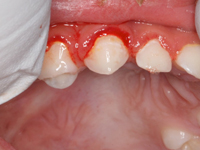
Bleeding Gums
- UNDERBITE: Underbite or crossbite can occur in growing children. Differences in the size of top and bottom jaws can cause crossbite. Or your child’s teeth may not be positioned exactly right. Crossbites usually do not require treatment at this age. However, your child’s doctor or dentist should watch crossbites as your child grows. Some crossbites may require treatment in the future.
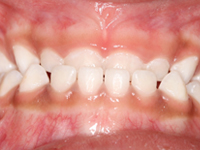
Underbite

General Oral Health Information

The goal is for 2 year old children to be using a cup and not the bottle. To help prevent cavities, reduce sweetened beverages. If your child has any sweetened beverages (milk or juice) before bed, brush the teeth after drinking and before bedtime. Offer only water after or if your child wakes up in the middle of the night.
If your child drinks juice, give only 4-6 ounces (1/2 a cup or 1 juice box) per day. Juice has a lot of sugar that can coat the teeth and cause cavities. If you dilute the juice (add water), give it to your child only during meal times. Between meals, you should give your child water only.
Your child should drink only about 16 ounces of cow’s milk per day. Drinking any sugary drinks can increase the risk for cavities. Also too much milk may cause your child to not get enough iron (iron deficient). Cut back on your child’s snacking and limit snacks to low-sugar foods. Avoid sticky foods including gummy vitamins.

Scientists have learned that mothers with cavities tend to have children with cavities. Also, these cavities are more severe. Mothers can pass cavity-causing germs to their children. This is why you should keep your mouth cavity free and visit the dentist regularly. Anyone else who cares for your child should do the same.
Fluoride helps prevent cavities. It is also considered a ‘vitamin’ for teeth. There are three main sources for fluoride—water, toothpaste, and professionally applied.
Water
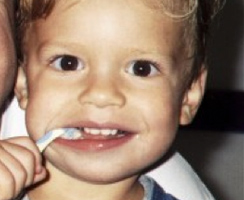
Most city water has fluoride added. If your family uses well water, it may have too little or too much fluoride. Ask your doctor or dentist to run a test to see how much fluoride is in your well water. Your child may need a different amount of fluoride. Ask your doctor or dentist to help you learn the best way for your child to get the right amount. They may prescribe a supplement if needed. You might be able to give your child bottled water that has fluoride added. Here is a website to learn more about fluoridated bottled water. http://www.bottledwater.org/fluoride.
Toothpaste
Many brands of toothpaste have fluoride added. Check the label to make sure, or ask your doctor or dentist to recommend a brand to use. Use a small amount of fluoridated toothpaste to brush your child’s teeth. See the section on Brushing Teeth Tab 2 in Your Baby’s Mouth section for more information.
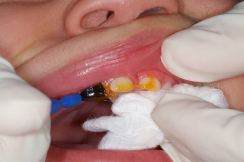
Fluoride Varnish
Professionally Applied
Varnish is a type of fluoride that a dentist or doctor paints on your baby’s teeth. It can reduce (decrease) cavities in baby teeth by one-third when painted on at least twice a year for children at risk for cavities. Varnish can be applied as soon as the first tooth comes into the mouth. Ask your dentist or doctor about putting fluoride varnish on your baby’s teeth.
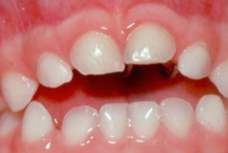
Discontinue use of a pacifier after age one year because it can increase your child’s risk of ear infections. Also, discourage thumb sucking. Prolonged pacifier use and thumb sucking may cause your child to have teeth that do not fit together. This is also known as a ‘hole in your smile’ (see picture).
Children are usually walking and starting to run at this age. Ages 2-3 years is a peak time for dental injuries in the baby teeth. Bone at this age is softer than in later childhood. When injuries happen, teeth will tend to move position rather than break.
Make sure the child’s surroundings are safe. Cap electrical outlets and cushion sharp corners on tables and bookshelves. Cover bathtub nozzles. If your child is starting to ride a tricycle or bicycle, have him/her wear a helmet. If your child rides with you on your bicycle, he/she should wear a helmet. Wearing a helmet will help prevent injury to the head and mouth. Contact your dentist if your child falls and injures his/her mouth or teeth. If you do not have a dentist, have a doctor to look at the injury.
Social and Emotional Growth (Development)

At this age your child is quite active. His/her language is developing rapidly. Children this age see themselves as being different from you. They focus on ‘doing it myself’. This may lead to struggles for control, and your child may have tantrums.
Your toddler may wish to try brushing his/her own teeth and you should encourage this. Use water only or a fluoride-free toothpaste when a child is brushing his/her own teeth. After the child has brushed, an adult should complete the brushing using fluoride toothpaste. Children cannot fully brush their teeth on their own until they are 8 or 9 years old. Another way to think about this is ‘until they are old enough to clean your kitchen floor’. The amount of toothpaste you should use is about the size of a grain of rice (see picture in Brushing Teeth Tab 2 in Your Baby’s Mouth section).
After simple routines, reward your toddler with things that are worth valuing (like reading books). Simple routines may include brushing teeth and going to the dentist. Consider having your child pretend to ‘brush the teeth’ of a favorite stuffed toy or doll as part of a bedtime routine.
Avoid using foods as ‘treats’. Take your child to a dentist for regular check-ups. Ask your doctor for a referral to a dentist that cares for young children. Set a good example for your child by taking care of your own teeth and gums. Help prevent passing germs that cause cavities to your child by taking care of your teeth and gums.
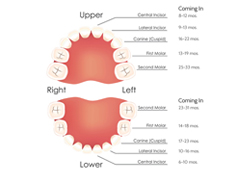
 Teething Table
Teething Table